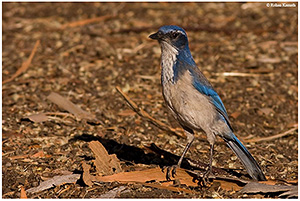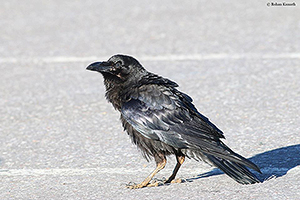Walking vs. Hopping |
|
|---|---|



photographs of a Western Scrub-Jay (top) and American Raven (bottom) by Rohan Kamath and an American Crow (middle) Tom Grey |
A
bird moving along a telephone wire does not walk like a
tightrope artist; instead, the bird will "sidestep,"
"switch-sidle," or "hop." Sidestepping (the way that people
typically move along a ledge) involves alternately lifting
each foot and moving it to the side while continuing to keep
the same foot ahead. Switch-sidling means moving to the
right or to the left by crossing one foot over the other in
an exaggerated "pigeon-toed" step. Hopping, of course,
requires moving both feet simultaneously. When unconstrained by such a narrow perch, many birds walk or run using the alternating strides typical of most bipeds. Others, particularly small, arboreally inclined species, commonly hop. It is uncertain why hopping is more common in smaller birds. The evidence seems to point to economy of effort: short-legged birds move farther in a single hop than they do taking several steps, whereas it is more economical for larger birds, with longer strides, to move one leg at a time. Although birds of the same taxonomic groups frequently share a common pattern of locomotion on the ground, the patterns often have exceptions. Most passerines hop, but others, such as larks, pipits, starlings, and meadowlarks, typically stride. Within the family Corvidae, jays hop whereas crows stride. Diverse species, including robins, ravens, and blackbirds, both hop and stride. Whether a physically unconstrained bird hops or strides is not just a question of anatomy; speed also affects choice of locomotion -- a hopper in a hurry tends to break into a run. Leg length is not only related to locomotory mode but also associated, among other things, with foraging style. For example, among ground gleaners and waders, species with shorter legs forage in shallower debris or water. Some ground foragers (especially buntings, towhees, juncos, and sparrows) are more likely to use a method of foraging called "double-scratching," a maneuver involving little more than hopping in place. But here, too, there is no simple division between birds that hop, stride, and double-scratch. Some striders double-scratch and some hoppers do not. |
| Recording the locomotory patterns in local bird species in different circumstances could be helpful in determining, for example, the conditions under which birds that typically hop when on perches (such as jays, flickers, and House Sparrows) continue to hop when on the ground and under which conditions they do not. | |
| SEE:
Feet;
Visual Displays;
How Do We Find Out About Bird Biology? Copyright ® 1988 by Paul R. Ehrlich, David S. Dobkin, and Darryl Wheye. |
|